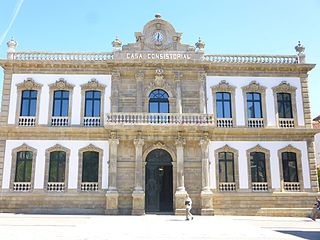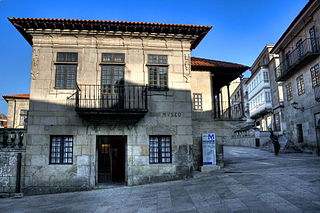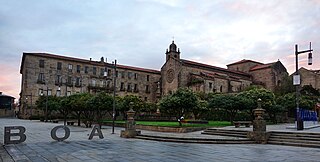
The Valle-Inclán High School is a large eclectic and Art Nouveau building located in the city centre of Pontevedra, Spain. It is named after the writer Valle-Inclán who studied and lived in Pontevedra. Today it is the seat of the Valle-Inclán Secondary School and was the first and the only secondary school in the province of Pontevedra from 1845 to 1927.

The Pontevedra City Hall in Pontevedra, Spain, is the seat of the city council of this Galician city. It is located at the eastern end of the Alameda de Pontevedra, on the edge of the old town. To the west it opens onto the pedestrian España Square.

The Church of Saint Bartholomew is a Catholic religious building in the city of Pontevedra, Galicia, Spain. The church was built in the late 17th century in the Baroque style as a place of worship and pastoral activities for the adjoining Jesuit college. The church was dedicated to Saint Bartholomew when it became a parish church in 1836.

The Pontevedra Museum is a museum in the Galician city of Pontevedra in Spain. It was founded by the Provincial Deputation of Pontevedra on 30 December 1927 and has six buildings for its exhibitions. It has permanent and temporary exhibition rooms. The museum's collections are multidisciplinary, classified into rooms for painting, sculpture, archaeology, decorative arts, engraving and ethnography.

The Palace of Mugartegui, or Palace of the Counts of Fefiñáns in Pontevedra, Spain, is a Baroque pazo dating from the 18th century. It currently houses the headquarters of the Regulatory Council of the Rías Baixas Designation of Origin.

The Palace of the Counts of Maceda, or Casa del Barón in Pontevedra, Spain, is an original Renaissance pazo dating from the 16th century. It is currently a four-star hotel belonging to the Paradores network.

The Casa de las Campanas is one of the three oldest buildings in the city of Pontevedra in Spain, and perhaps the oldest civil building. It is located in Don Filiberto street, at number 11, in the old town.

The Principal Theatre of Pontevedra (Teatro Principal de Pontevedra) is a theatre in the old town of Pontevedra (Spain).

The Café Moderno is an art nouveau and eclectic building located in St. Joseph's Square in Pontevedra, Spain. It is the building with the most important Art Nouveau interior in the city. It is currently the headquarters of one of the socio-cultural centres of Pontevedra Afundación, owned by the Abanca bank.

The Pazo de García Flórez is an 18th-century baroque pazo located between Sarmiento Street and Plaza de la Leña in the city of Pontevedra, Spain, in the heart of the old town.

The Pazo de Castro Monteagudo, is an 18th-century baroque pazo in Pasantería Street, next to the Plaza de la Leña in the city of Pontevedra, Spain, in the heart of the old town.

The Bank of Spain building is an eclectic early-20th-century building in the Spanish city of Pontevedra.

The Administrative building of the Xunta de Galicia in Pontevedra is an office complex designed to house the various public services of the Galician Government in Pontevedra, Spain. The building houses many of the Galician administration's departments and was designed by the architects Manuel Gallego Jorreto and Jacobo Rodríguez-Losada Allende.

The historic centre of Pontevedra (Spain) is the oldest part of the city. It is the second most important old town in Galicia after Santiago de Compostela, and was declared a historic-artistic complex on 23 February 1951.

The Convent of St. Francis is a Franciscan convent located in the city centre of Pontevedra (Spain), overlooking the Plaza de la Herrería. The Gothic church of San Francis is attached to the convent on the southeast side.

The Castelao building is a modern architectural building from the beginning of the 21st century located on the corner of Padre Amoedo Carballo and Sierra Street in Pontevedra, Spain, on the edge of the historic centre. It belongs to the Pontevedra Museum.

The Pontevedra Provincial Hospital is a building dating from 1897, located in the city centre of Pontevedra, Spain.

The Ciudad de la Justicia de Pontevedra or the Pontevedra Judicial Complex is an architectural and judicial complex of the city of Pontevedra (Spain), consisting of two large court buildings built in 1998 and 2019 in the A Parda district.

The calle Benito Corbal is a street in Pontevedra (Spain) located in the first urban expansion area of the city. It is one of the main streets of Pontevedra, known as the "Golden Mile".

Calle Sarmiento is a street in the Spanish city of Pontevedra, located in the city's historic centre.































